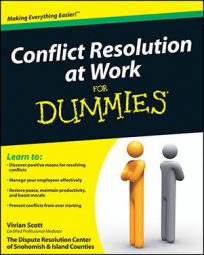Conflict in the workplace decreases efficiency and productivity, and that means lost profit. Taking a broad view of a conflict and considering both hard costs (like lost inventory) and soft costs (like team morale) helps you determine whether it’s time to step in. You may find some benefit to giving a conflict time to work out on its own, but you won’t know whether you’re doing the right thing without investigating to see whether your strategy has an impact on your teams’ productivity and the bottom line.
Hard costs associated with unresolved conflict
Hard costs are measurable costs that can be deducted from your financial statements. Though they’re tangible and usually easy to find and add up, managers often overlook them in the midst of conflict.
Wasted time: Time is money, and if people are avoiding one another and delaying outcomes, there’s a cost to that.
Pay attention to the number of hours being wasted in a day or week and consider whether you can afford to wait this out.
Lost workdays: If you’re expecting people who are in conflict (or who are surrounded by conflict) to work without resolution, they may be taking sick days just to avoid the stress.
Reduced productivity: When you have to work on a project with someone you’re not getting along with, the job takes longer and the final product is affected.
Performance and quality: Even if you don’t notice a marked drop in productivity, you’ll probably notice a diminished quality in the work that’s being delivered.
Healthcare costs associated with stress: Some workplace stressors may not be avoidable, but allowing the stress of unresolved conflict to continue only adds to the pressures your employees may already face.
Sabotage and theft: If employees reach a point where they feel no one cares about a situation, it’s not all that unusual for sabotage and theft to ensue.
Turnover: Regardless of the size of your organization, there’s a dollar amount associated with the cost of hiring, processing, and training every new employee.
Termination packages: Unresolved conflict can lead to a termination package that’s more costly to the company than if someone stays or leaves on good terms.
Legal costs: If a lawsuit is filed, you’ll spend money on legal fees and wages for all the employees who are addressing the court case, not to mention that the money you pay out isn’t going toward productivity or more sales.
Soft costs associated with unresolved conflict
Soft costs, on the surface, are those things that may not seem measurable or easily assigned a specific dollar amount, but they still affect your bottom line.
Morale: People are likely aware of an ongoing conflict, and this awareness can affect morale on all levels.
Decreased customer service: Taking care of employees who interact with customers keeps clients satisfied.
Reputation: Word gets around fast when people find a great enterprise that really values its employees. Disgruntled employees’ comments can scare off a future valued employee and potential customers.
Loss of skilled employees: Retaining skilled employees keeps production high and training time to a minimum.

